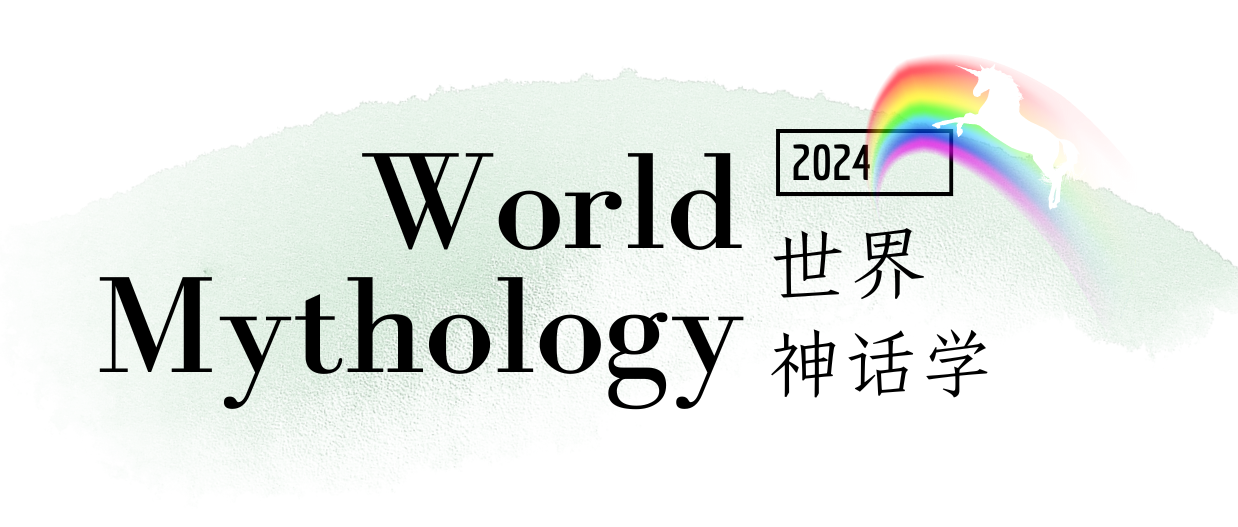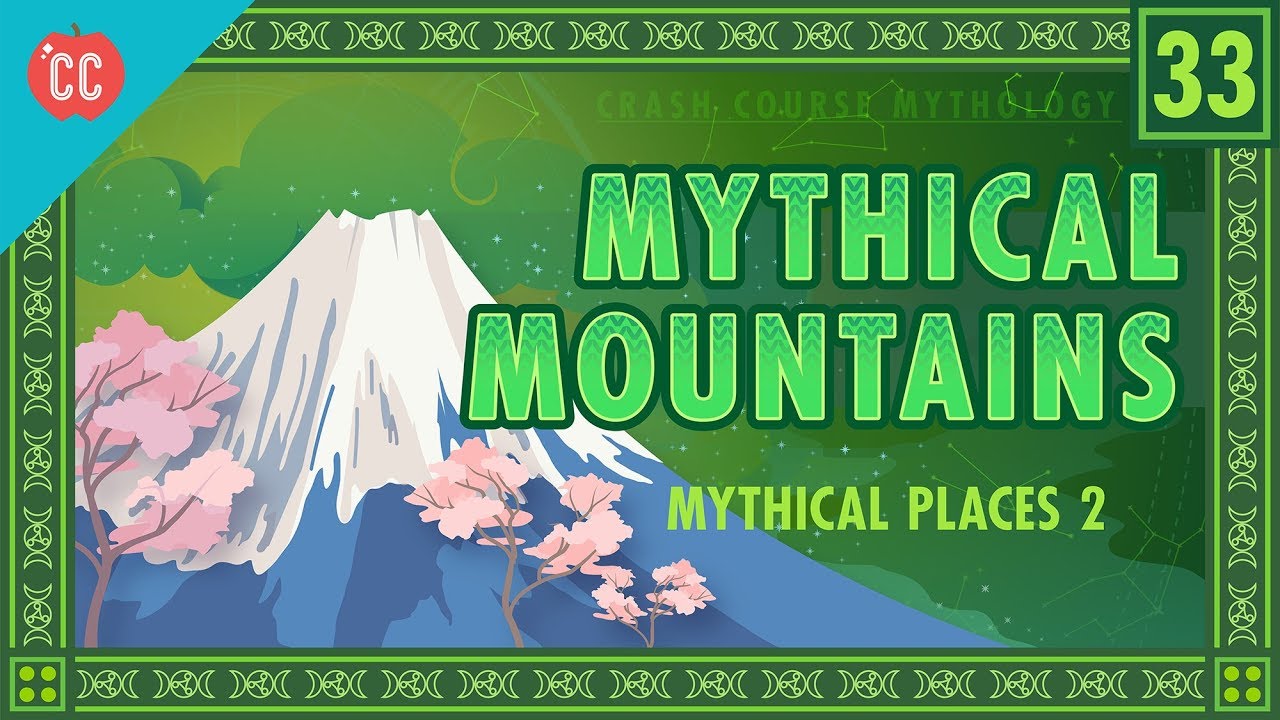
版权归Crash Course公开课所有,本文仅作读文学习使用,如侵权,请联系搬运工删除。
该本仅分段,未作精细校验,可能会出现单词错误,语义不详等问题。讲究读文体验的朋友也可等搬运工修订注释后再读。
(33)
Mythical Mountains

Description
🌳 Our mythical places series continues, and this week Mike Rugnetta is talking about some stories that revolve around mountains. Mountains loom large in human stories, not least because mountains are, well, large. So ascend with us to the lofty peaks of The Ten Thousand Treasure Mountain in China, and Mount Fuji in Japan.
🌳
1. This is Crash Course Mythology, his is Crash Course Mythology and today, we're following up our spelunking episode with some rock-climbing.
That's right, today we're taking on mountains of myth. Big mountains, small mountains, holy mountains, volcanic mountains...
In myth, mountains are mysterious, dangerous, and often have cool stuff inside them. Because they reach toward the sky, they often host the homes gods.
🌳
2. Mount Olympus is probably the best-known mountain that's both home to a pantheon and also a real place where you can go and eat grape leaves and drink ouzo. And even without all that Greek grog, mountains are perilous, as any one who's spent any time climbing them knows. And this makes them a good spot for hero myths.
Mountains are often the homes of monsters, the sites of avalanches, basically big 'ol heap of challenge. And if you're wondering now why anyone would ever go there, well you can't forget that mountains also contain valuable minerals. And in myths, that means that they're the site of great treasure, especially gold.
🌳
3. Today we're going to look at two myths: one from China and one from Japan. In the first story we'll encounter a mountain full of treasures, though most of those treasures are a lot more utilitarian than gold. We're also going to look at a mountain that's a treasure itself in that it has a god associated with it. A very competitive god.
A perfect example of a mountain stuffed with treasure comes from China, where people tell the story of Ko-Li and the Ten Thousand Treasure Mountain. It's a story of magic artifacts and a treacherous king.
🌳
4. But in the end, both Ko-Li and his mother demonstrate self-sacrifice and hard work.
Ko-Li and his mother live in a valley among the high mountains. They're too poor to have rice or corn, so they survive by eating roots that Ko-Li digs up. One day, he's only able to dig up enough food for one person.
So he gives the roots to his mother, saying he isn't hungry. But his mother refuses, saying she can't take the food while Ko-Li wastes away.
🌳
5. Just then, an old man with a long, white beard appears at the door. They give their food to this old father and, after he eats, Ko-Li picks him up and carries him back to his home in the mountains.
When they arrive at the old man's home, they're greeted by his beautiful daughter. In gratitude, the old man asks her to give Ko-Li her earrings as a reward for his virtue.
As it turns out, these earrings are also keys to the Ten Thousand Treasure Mountain. One is made of gold and it opens the secret door. The other is silver and it allows you to leave.
🌳
6. Ko-Li takes the earrings and unlocks the door to the treasure trove. Inside, the mountain is filled with incredible treasures: gold, silver, pearls... But Ko-Li is both humble and practical.
He chooses a simple white stone grinder so that he'll be able to earn a living grinding grain. He lets himself out with the silver earring and brings the grinder home to his mother.
As soon as Ko-Li tries to use the grinder, he discovers that, instead of grinding grains, it actually produces corn. Ko-Li and his mother can't believe their luck. And they take the magical corn to share with the rest of their village.
🌳
7. Eventually, news of this magical corn producing grinder reaches the king. He orders an official to travel to the village and bring him this magic grinder. The official arrives and demands the grinder.
But the second he touches it, it crumbles into a pile of lime. The king is furious and has the official beheaded.
Without the magic grinder, it isn't long before Ko-Li and his mother are hungry again. Ko-Li goes back into the Ten Thousand Treasure Mountain and uses the golden earring.
🌳
8. This time, he chooses a yellow stone mortar that magically produces white rice. He silver-earrings himself out, takes the mortar home, and before long the king is hearing stories about magical rice!
He orders another official to get the mortar. The official arrives at the village, grabs it, wouldn't you know? It turns to lime. Another official loses his head.
Hungry again, Ko-Li returns to the mountain. This time, he chooses a hoe. At hom, he pulls the hoe across the ground and giant corn stalks grow. Ko-Li shares his food with the villagers and again, the king hears the news.
🌳
9. This time, though, rather than try to seize the hoe, officials seize Ko-Li. The king demands to know, "Where are you getting these wonderful treasures?!"
Ko-Li tells the greedy king about the Ten Thousand Treasure Mountain. "I open the door in the mountain with this gold earring and-"but then and there, the king snatches the gold earring and sets off immediately.
🌳
10. The king rides as fast as he can to the mountain and gets inside. As the gold key grants his access, his eyes fill with visions of treasure. But behind him, the door to the mountain closes with Ko-Li and the freedom-granting silver earring outside.
Now, you might think that Ko-Li would be worried about the king trapped in the mountain, where he'll probably starve to death or asphyxiate or get crushed to death by all that treasure, but Ko-Li has more pressing concerns.
🌳
11. He's lost one of the girl's earrings! His mother bundles up two bushels of corn and takes it to the old man's home to apologize. But when she arrives, old father tells her, "We don't need your corn! Use it to feed your village."
The old man goes on to say, "I've decided your son is so honest and hard-working, he and my daughter should be married."
🌳
12. Which is to say that the generous, hard-working Ko-Li lived happily ever after while the greedy king perished underground surrounded by useless riches. But were they even riches? Thinking face emoji. 🤔️
The Ten Thousand Treasure Mountain represents an important opportunity and location for our main character. But some mountains are the main characters themselves.
🌳
13. Even today, Japan has a complex religious landscape. A mix of the ancient religion Shintoism, the 6th century edition of Buddhism, and more recently a dash of Christianity.
According to Leonard and McClure, "Shinto views all land-forms - indeed all things - as being closely associated with a particular Kami." A Kami is a kind of god and mountains, trees, stones, lakes, even grains have their own Kami.
🌳
14. When Buddhism arrived in Japan in the 6th century BCE, it needed to assimilate to the preexisting animistic religion and the result was a syncretic combination of Buddhist figures and styles of worship with Shinto shrines and gods.
One way to see this relationship is to look at one myth involving two famous mountains and the Buddha Amida.
🌳
15. The story starts long ago, with an argument between Mount Yatsugatake and Mount Fuji. Both mountains are animated by their own Kami. One day, Yatsugatake and Fuji begin to argue about which one of them is taller.
No matter how they debate, they can't reach an answer, so they ask Buddha Amida to be the judge. Amida runs a pipe between the tops of the two mountains and pours water in it to see which way it will flow.
🌳
16. The water flows downward toward Fuji. Yatsugatake is taller. When Amida announces the results, Fuji is furious! She attacks Yatsugatake with a stick, smashing great gaps into his top. And that's why Yatsugatake has eight peaks.
Many mountains are revered in Japanese culture, but none more so than Mount Fuji. I guess it's always to revere a mountain that might rough you up. But Mount Fuji and Asamano Okami, the Kami associated with her, aren't always depicted so aggressively.
🌳
17. For instance, there was once a boy named Yosoji who lives near Mount Fuji. Yosoji's mother has smallpox and is dying, so he asks the magician, Kamo Yamakiko, for help.
Kamo Yamakiko tells Yosoji, if he wants to help save his mother, he must fetch water from the source of a small stream near the southwest side of Mount Fuji.
Yosoji sets out but is confounded when the path branches into three paths. Suddenly, a beautiful girl, dressed in white, steps out of the forest and leads him down the correct path to the stream.
And in that stream, we find some in the story we're gonna tell.
🌳
18. When Yosoji arrives at the stream, the girl tells him to drink and then gather water for his mother. She then leads Yosoji back to the crossroads and tells him to meet her there again in three days because he's going to need more of the magical water.
Yosoji does as he's told. He takes the water back to his home and gives it to his mother to drink, along with many other sick villagers. When he runs out of water, he returns to meet the mysterious girl.
🌳
19. He does this again and again. After five trips, his mother, and the rest of the sick villagers are cured. The villagers praise him but Yosoji knows that he owes it all to the beautiful girl, so he goes to thank her.
When Yosoji arrives, the stream has dried up. He's surprised and sad. He prays for the girl to appear so he can thank her properly. When he rises from prayer, poof! There she is.
🌳
20. Yosoji thanks her and begs the girl to reveal her name, because, you know, beautiful girl from the magical stream is a pretty weird thing to call someone. But she won't tell him.
Instead, she swings a branch of camellia in the air and a cloud flies down from Mount Fuji, enveloping her and carrying her back to the sacred mountain.
That is when Yosoji realizes the girl is actually the goddess of Mount Fuji, moonlighting as a stream Kami. Right then and there, his heart fills with love for her. He kneels down before the retreating goddess and she tosses the camellia branch to him, a symbol of their connection.
🌳
21. That was some peak mythology. It's only downhill from here. And also very touching, showing us the more generous side of mountains.
See? It's not all rocks and suffocation. Mountains are also a place of pure, life-giving water. They're as varied as any pantheon we've encountered. Though seemingly less incestuous, which is probably a good thing.
🌳
22. Today, we've seen rich mountains, competitive mountains, angry mountains, and finally a loving and generous mountain. We've also realized that, while gods are often represented as people and animals and people-animal hybrids, elements of the natural world like mountains in all their mile-high power and grandeur, can represent gods too. Gods you can climb. Is there nothing we humans won't anthropomorphize?
Thanks for watching and see you next time, when we're going to make like some trees and myth. And I, for one, am relieved to think the king probably didn't starve as all Ten Thousand Treasures in the mountain seem to produce food.
To be continued…
未完待续…

